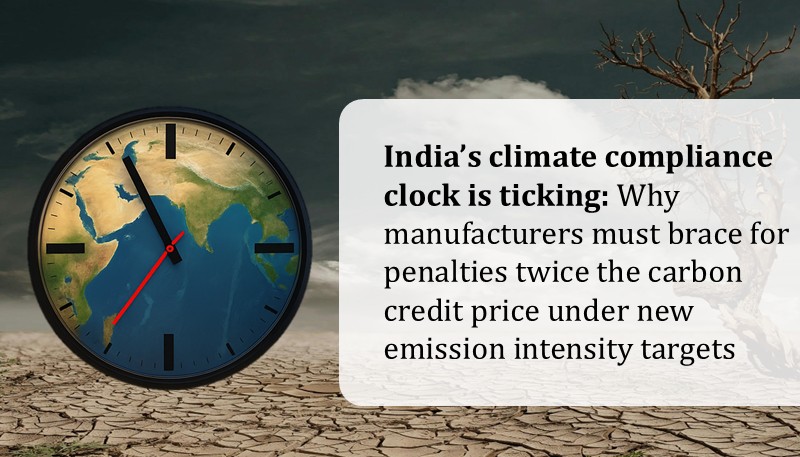India’s climate compliance clock is ticking – Why manufacturers must brace for penalties twice the carbon credit price under new emission intensity targets

On the 23rd of June, 2025, the Ministry of Environment, Forest and Climate Change (“MoEFCC”) has issued a draft notification introducing the Greenhouse Gas Emission Intensity Target Rules, 2025 (“Draft Rules”) to facilitate the implementation of the Carbon Credit Trading Scheme, 2023 (CCT Scheme). Those likely to be impacted by the Rules were asked to file their objections or suggestions within 60 days.
The CCT Scheme was introduced by the Ministry of Power under the Energy Conservation Act, 2001, outlining India’s carbon market framework for trading carbon credits to reduce greenhouse gas emissions. A central component of the scheme featured a compliance mechanism which mandated the notification of Greenhouse Gas Emission Intensity (“GEI”) targets for obligated entities by the Ministry. The obligated entities are primarily energy-intensive industries in India, including aluminium, cement, iron & steel, and petroleum refinery sectors. Earlier the legislative framework around pollution control in India did not essentially focus on greenhouse gas emissions nor did they set any measurable targets for greenhouse gas emission intensity for industrial sectors. However, now under the Draft Rules, specific reduction targets have been mandated for the amount of greenhouse gases emitted per unit of product in key energy-intensive sectors.
The primary objectives of these draft rules are twofold: first, to actively contribute to India’s Nationally Determined Contribution (NDC) by achieving a reduction in Greenhouse Gas Emission Intensity (GEI) through the mitigation of greenhouse gas emissions via reduction, removal, or avoidance. Secondly, the rules aim to foster the widespread adoption of sustainable and cutting-edge technologies within traditionally high-emitting industries, thereby directly addressing the challenges posed by climate change and paving the way for a more environmentally responsible industrial landscape.
The Draft Rules propose emission intensity targets for designated industrial sectors, to be implemented by the Bureau of energy efficiency (BEE). These targets, expressed as tonnes of CO₂ equivalent emissions per tonne of equivalent production, will be applicable for the compliance periods spanning 2025-26 to 2026-27, utilizing baseline data from 2023-24. Entities failing to meet these mandated targets will be obligated to procure carbon credit certificates via the Indian carbon market portal. Further, it is crucial to note that the Draft Rules propose levying of environmental compensation on any obligated entity, in case of non-compliance, which will be equal to twice of the average price at which carbon credit certificate is traded. The Draft Rules also allow for banking of any surplus certificates for future compliance periods thereby providing an incentive to the companies to reduce their carbon emissions.
The introduction of the Greenhouse Gas Emission Intensity Target Rules, 2025 marks a paradigm shift in the regulatory landscape for greenhouse gas emissions from a broader perspective of environmental protection measures and voluntary initiatives towards a more targeted and market-driven approach, with measurable climate accountability. The Draft Rules not only incentivize emission reductions and promote the adoption of sustainable technologies but also provide a structured approach by setting clear GEI targets for energy-intensive industries and linking to a carbon credit trading mechanism. It is a step forward in India’s journey towards a low carbon economy and a green environmentally efficient industrial growth.
For energy-intensive industries, this is a wake-up call. Climate compliance can no longer remain a CSR checkbox or a voluntary initiative. Businesses must now:
-
Assess their GEI baselines,
-
Plan for mitigation or offset pathways,
-
Engage actively with the Indian Carbon Market, and
-
Ensure timely registration and reporting.
The message is clear: compliance is no longer optional, and delay can be costly, not just financially, but reputationally.
Written by: Animesh Ankur
Co-authored by: Amiya Mukherjee
Disclaimer
This content is intended for informational purposes only and does not constitute a legal opinion. Despite our efforts to maintain accuracy, we do not make representations, warranties or undertakings regarding the quality, completeness or reliability of the content. Readers are encouraged to seek legal counsel prior to acting upon any of the information provided herein. This content, including the design, text, graphics, their selection and arrangement, is Copyright 2025, Lexplosion Solutions Private Limited or its licensors. ALL RIGHTS RESERVED, and all moral rights are asserted and reserved.
For any clarifications, please reach out to us at 91-33-40618083 or inquiries@lexplosion.in. Refer to our privacy policy by clicking here.